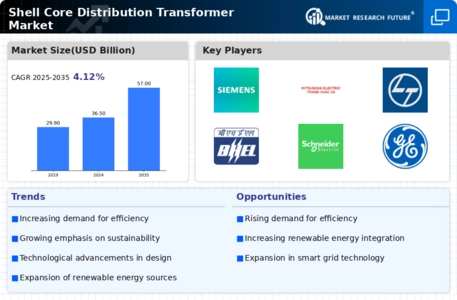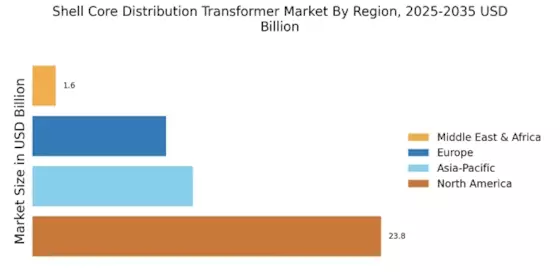Increasing Urbanization
The Shell Core Distribution Transformer Market appears to be significantly influenced by the trend of increasing urbanization. As populations migrate towards urban centers, the demand for reliable and efficient power distribution systems escalates. Urban areas require robust electrical infrastructure to support residential, commercial, and industrial activities. This surge in demand for electricity necessitates the deployment of advanced distribution transformers, including shell core types, which are known for their efficiency and compact design. According to recent data, urbanization rates are projected to rise, leading to an estimated increase in transformer installations by approximately 5% annually. This trend suggests that the Shell Core Distribution Transformer Market is poised for growth as cities expand and require enhanced power distribution capabilities.
Rising Renewable Energy Integration
The integration of renewable energy sources into the power grid is a pivotal driver for the Shell Core Distribution Transformer Market. As nations strive to reduce carbon emissions and transition towards sustainable energy solutions, the demand for transformers that can efficiently manage variable energy sources, such as solar and wind, is increasing. Shell core transformers are particularly suited for this application due to their ability to handle fluctuating loads and improve overall grid stability. Market data indicates that the share of renewables in the energy mix is expected to reach 30% by 2030, thereby necessitating the installation of advanced distribution transformers. This shift towards renewable energy integration is likely to bolster the Shell Core Distribution Transformer Market as utilities seek to modernize their infrastructure.
Government Regulations and Standards
Government regulations and standards aimed at improving energy efficiency and reducing environmental impact are influencing the Shell Core Distribution Transformer Market. Many countries have implemented stringent efficiency standards for electrical equipment, including transformers. Compliance with these regulations often necessitates the adoption of more efficient shell core transformers, which are designed to meet or exceed these standards. For instance, regulations in several regions mandate that new transformers achieve a minimum efficiency rating, driving demand for advanced designs. As a result, the Shell Core Distribution Transformer Market is expected to experience growth as manufacturers innovate to meet these regulatory requirements and utilities upgrade their infrastructure to comply with new standards.
Technological Innovations in Transformer Design
Technological advancements in transformer design are driving the Shell Core Distribution Transformer Market forward. Innovations such as improved core materials, enhanced cooling systems, and smart grid technologies are making shell core transformers more efficient and reliable. These advancements not only reduce energy losses but also extend the lifespan of transformers, making them a preferred choice for utilities. Recent studies suggest that the adoption of smart transformers, which incorporate digital monitoring and control capabilities, is expected to grow by 20% over the next five years. This trend indicates that the Shell Core Distribution Transformer Market is likely to benefit from ongoing research and development efforts aimed at enhancing transformer performance and functionality.
Growing Industrialization and Infrastructure Development
The ongoing industrialization and infrastructure development in various regions are key drivers for the Shell Core Distribution Transformer Market. As industries expand and new facilities are established, the demand for reliable power distribution systems increases. Shell core transformers, known for their compact size and efficiency, are particularly well-suited for industrial applications where space and performance are critical. Market analysis indicates that infrastructure investments are projected to rise significantly, with many countries allocating substantial budgets for energy projects. This trend suggests that the Shell Core Distribution Transformer Market will likely see increased demand as industries seek to enhance their power distribution capabilities to support growth and operational efficiency.


















Leave a Comment